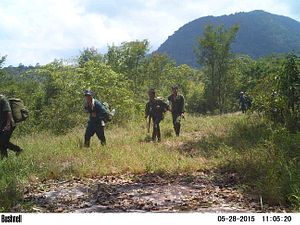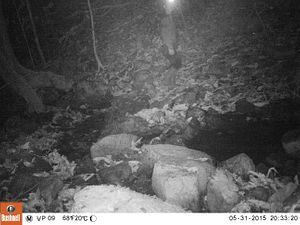Virachey National Park’s location is both a blessing and a curse. Carved out of a chunk of mountains that demarcates the Cambodian, Lao, and Vietnamese borders and terminating in a wisp of terrain known as the “Dragon’s Tail,” the wildlife of this beleaguered and beautiful park has managed to cling to existence thanks almost exclusively to its rugged terrain. Many Cambodian protected areas lay on relatively flat land that makes it all too easy for poachers and loggers to get around in, but that ease of navigation ends at Virachey, which is actually the southern flank of a westward-stretching arm of the Annamite Cordillera. On the Vietnamese and Lao sides of the borders with Virachey the mountains and jungles spread onward, echoing the morning cry of gibbons and the call of the hornbills that always impress visitors to Virachey. This intriguing topography is also a problem because Lao and Vietnamese poachers find it all too easy to sneak across the wild border areas to set snares and shoot rare species like douc langurs out of the trees.
Indeed, Vietnamese and Lao poaching inside Virachey appears to be on the increase, as Habitat ID’s camera traps are now showing. While locals also poach, they do not, according to our camera trap records, seem to be as well-armed, determined, and well-organized as the Vietnamese, who have long made illegal border crossings into Cambodia via Laos and Vietnam to hunt out the last of the tigers and elephants. Local people are allowed to enter the park to collect Non-Timber Forest Products (NTFPs) and to fish and even hunt non-threatened species such as wild pig and barking deer. In fact, the locals caught on our film appear positively benevolent compared to the eerily determined Vietnamese poachers stalking the remote Virachey mountains in the dark of night.
Virachey National Park rangers have begun to do more patrols in recent years, especially in 2016. In addition, Cambodia’s Ministry of Environment has recently decided to add 1 million hectares of protected areas to the kingdom’s forests, and Virachey will be a beneficiary of this. Still, more help is needed. Anyone enjoying the pictures in this photo essay should consider contacting Virachey National Park to see how they can help out.
Some may question the wisdom of publishing camera trap photos. I have pondered this myself. However, it is clear that poachers are already very active in the park; they don’t need Internet photos to tell them where to go. Furthermore, the area that is now Virachey National Park has been getting absolutely hammered by poaching and logging since the 1980s—that’s well over 30 years of constant hunting. Are we really telling the poachers something they don’t know? After all, they did an excellent job of hunting out the charismatic megafauna well before camera traps ever showed up on the scene. So, let this photo essay serve as an S.O.S. Is there anybody out there who is interested in protecting the wildlife of the last great forest of Indochina?
Greg McCann is the Field Coordinator for Habitat ID, an NGO that specializes in camera-trapping in under-prioritized national parks in Southeast Asia.


























































